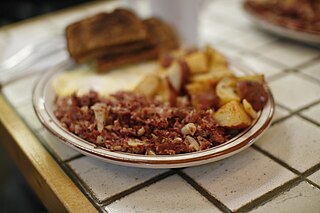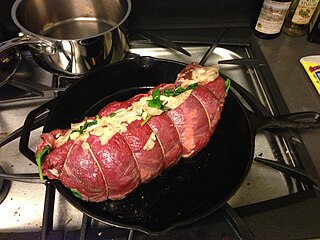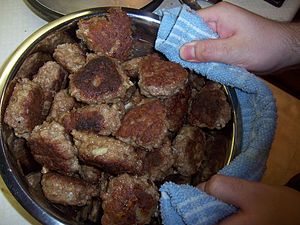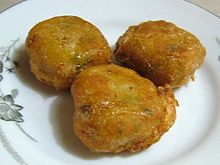
A sausage is a type of meat product usually made from ground meat—often pork, beef, or poultry—along with salt, spices and other flavourings. Other ingredients, such as grains or breadcrumbs, may be included as fillers or extenders.

Meatloaf is a dish of ground meat that has been combined with other ingredients and formed into the shape of a loaf, then baked or smoked. The final shape is either hand-formed on a baking tray, or pan-formed by cooking it in a loaf pan. It is usually made with ground beef, although ground lamb, pork, veal, venison, poultry, and seafood are also used, sometimes in combination. Vegetarian adaptations of meatloaf may use imitation meat or pulses.

Polish cuisine is a style of food preparation originating in and widely popular in Poland. Due to Poland's history, Polish cuisine has evolved over the centuries to be very eclectic, and shares many similarities with other national cuisines. Polish cooking in other cultures is often referred to as à la polonaise.

Hash is a dish consisting of chopped meat, potatoes, and fried onions. The name is derived from French: hacher, meaning 'to chop'. It originated as a way to use up leftovers. In the U.S. by the 1860s, a cheap restaurant was called a "hash house" or "hashery."

A schnitzel is a thin slice of meat. The meat is usually thinned by pounding with a meat tenderizer. Most commonly, the meat is breaded before frying. Breaded schnitzel is popular in many countries and is made using veal, pork, chicken, mutton, beef, or turkey. Schnitzel originated as wiener schnitzel and is very similar to other breaded meat dishes.

Ukrainian cuisine is the collection of the various cooking traditions of the people of Ukraine, one of the largest and most populous European countries. It is heavily influenced by the rich dark soil (chornozem) from which its ingredients come, and often involves many components. Traditional Ukrainian dishes often experience a complex heating process – "at first they are fried or boiled, and then stewed or baked. This is the most distinctive feature of Ukrainian cuisine".

A frikandel is a traditional snack originating from the Netherlands, a sort of minced-meat sausage, of which the modern version was developed after World War II. The history of this snack in the Spanish Netherlands goes back to the 17th century.

Bulgarian cuisine is part of the cuisine of Southeast Europe, sharing characteristics with other Balkan cuisines. Bulgarian cooking traditions are diverse because of geographical factors such as climatic conditions suitable for a variety of vegetables, herbs, and fruit. Aside from the variety of local Bulgarian dishes, Bulgarian cuisine shares a number of dishes with its neighboring countries, in particular with Turkish and Greek cuisine.

Frikkadel is a traditional Afrikaner dish consisting of usually baked, but sometimes deep-fried, meatballs prepared with onion, bread, eggs, vinegar and spices. These meatballs can be served hot or cold. Many recipes have put a modern twist on this traditional recipe such as alternating chicken and lamb with the traditional beef staple. Frikkadel are also popular in Sri Lankan cuisine by way of the Burgher people.
Cutlet refers to:
- a thin slice of meat from the leg or ribs of mutton, veal, pork, or chicken
- a dish made of such slice, often breaded
- a croquette or cutlet-shaped patty made of ground meat
- a kind of fish cut where the fish is sliced perpendicular to the spine, rather than parallel ; often synonymous with steak
- a prawn or shrimp with its head and outer shell removed, leaving only the flesh and tail
- a mash of vegetables fried with bread

A roulade is a dish of filled rolled meat or pastry. Roulade can be savory or sweet. Swiss roll is an example of a sweet roulade. Traditionally found in various European cuisines, the term roulade originates from the French word rouler, meaning "to roll".

A meatball is ground meat (mince) rolled into a ball, sometimes along with other ingredients, such as bread crumbs, minced onion, eggs, butter, and seasoning. Meatballs are cooked by frying, baking, steaming, or braising in sauce. There are many types of meatballs using different types of meats and spices. The term is sometimes extended to meatless versions based on vegetables or fish; the latter are also commonly known as fish balls.

Perkedel are vegetable fritters from Indonesian cuisine. Most common perkedel are made from mashed potatoes, yet there are other popular variations, such as perkedel jagung and perkedel tahu and perkedel ikan. It is called perkedel in much of Indonesia; However, it is called begedil in Javanese as well as Malaysia and Singapore. This could suggest that this fried dish was introduced by Javanese immigrants to Malaysia and Singapore.

Breaded cutlet or braised cutlet is a dish made from coating a cutlet of meat with breading or batter and either frying or baking it.

Indonesian noodles are a significant aspect of Indonesian cuisine which is itself very diverse. Indonesian cuisine recognizes many types of noodles, with each region of the country often developing its own distinct recipes.

Indo cuisine is a fusion cooking and cuisine tradition, mainly existing in Indonesia and the Netherlands, as well as Belgium, South Africa and Suriname. This cuisine characterized of fusion cuisine that consists of original Indonesian cuisine with Eurasian-influences—mainly Dutch, also Portuguese, Spanish, French and British—and vice versa. Nowaday, not only Indo people consume Indo cuisine, but also Indonesians and Dutch people.
















